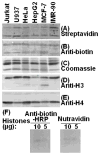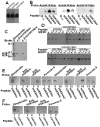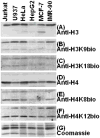Biotinylation is a natural, albeit rare, modification of human histones
- PMID: 21930408
- PMCID: PMC3224183
- DOI: 10.1016/j.ymgme.2011.08.030
Biotinylation is a natural, albeit rare, modification of human histones
Abstract
Previous studies suggest that histones H3 and H4 are posttranslationally modified by binding of the vitamin biotin, catalyzed by holocarboxylase synthetase (HCS). Albeit a rare epigenetic mark, biotinylated histones were repeatedly shown to be enriched in repeat regions and repressed loci, participating in the maintenance of genome stability and gene regulation. Recently, a team of investigators failed to detect biotinylated histones and proposed that biotinylation is not a natural modification of histones, but rather an assay artifact. Here, we describe the results of experiments, including the comparison of various analytical protocols, antibodies, cell lines, classes of histones, and radiotracers. These studies provide unambiguous evidence that biotinylation is a natural, albeit rare, histone modification. Less than 0.001% of human histones H3 and H4 are biotinylated, raising concerns that the abundance might too low to elicit biological effects in vivo. We integrated information from this study, previous studies, and ongoing research efforts to present a new working model in which biological effects are caused by a role of HCS in multiprotein complexes in chromatin. In this model, docking of HCS in chromatin causes the occasional binding of biotin to histones as a tracer for HCS binding sites.
Copyright © 2011 Elsevier Inc. All rights reserved.
Figures








References
-
- Wolffe A. Chromatin. 3. Academic Press; San Diego, CA: 1998.
-
- Luger K, Mader AW, Richmond RK, Sargent DF, Richmond TJ. Crystal structure of the nucleosome core particle at 2.8 A resolution. Nature. 1997;389:251–260. - PubMed
-
- Kouzarides T, Berger SL. Chromatin modifications and their mechanism of action. In: Allis CD, Jenuwein T, Reinberg D, editors. Epigenetics. Cold Spring Harbor Press; Cold Spring Harbor, NY: 2007. pp. 191–209.
-
- Cheung WL, Ajiro K, Samejima K, Kloc M, Cheung P, Mizzen CA, Beeser A, Etkin LD, Chernoff J, Earnshaw WC, Allis CD. Apoptotic phosphorylation of histone H2B is mediated by mammalian sterile twenty kinase. Cell. 2003;113:507–517. - PubMed
-
- Hymes J, Fleischhauer K, Wolf B. Biotinylation of histones by human serum biotinidase: assessment of biotinyl-transferase activity in sera from normal individuals and children with biotinidase deficiency. Biochem Mol Med. 1995;56:76–83. - PubMed
Publication types
MeSH terms
Substances
Grants and funding
LinkOut - more resources
Full Text Sources
Other Literature Sources

